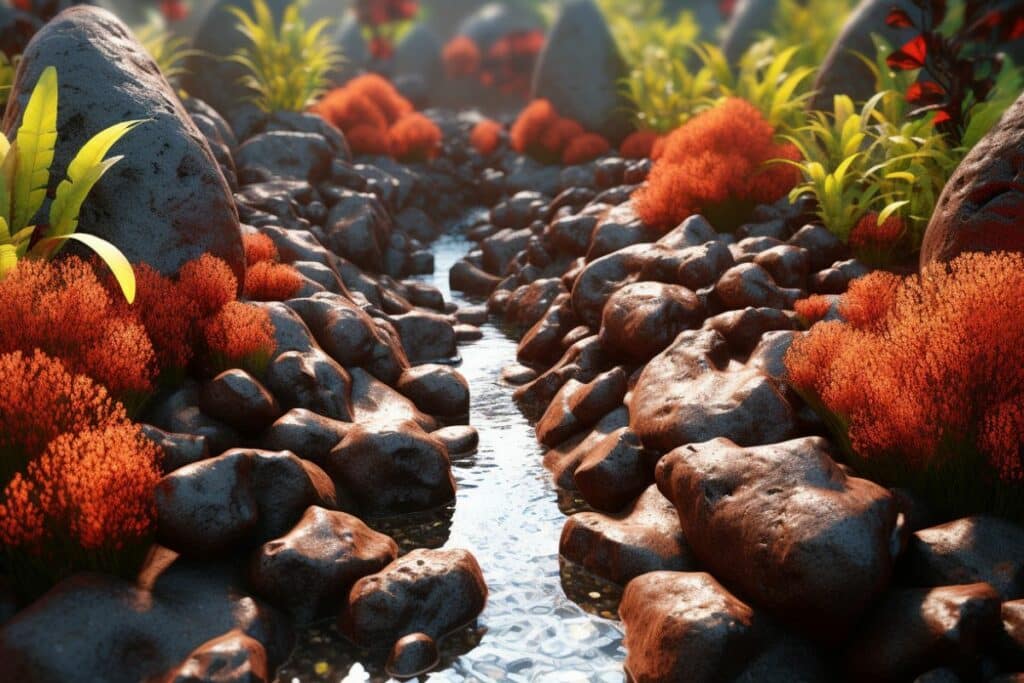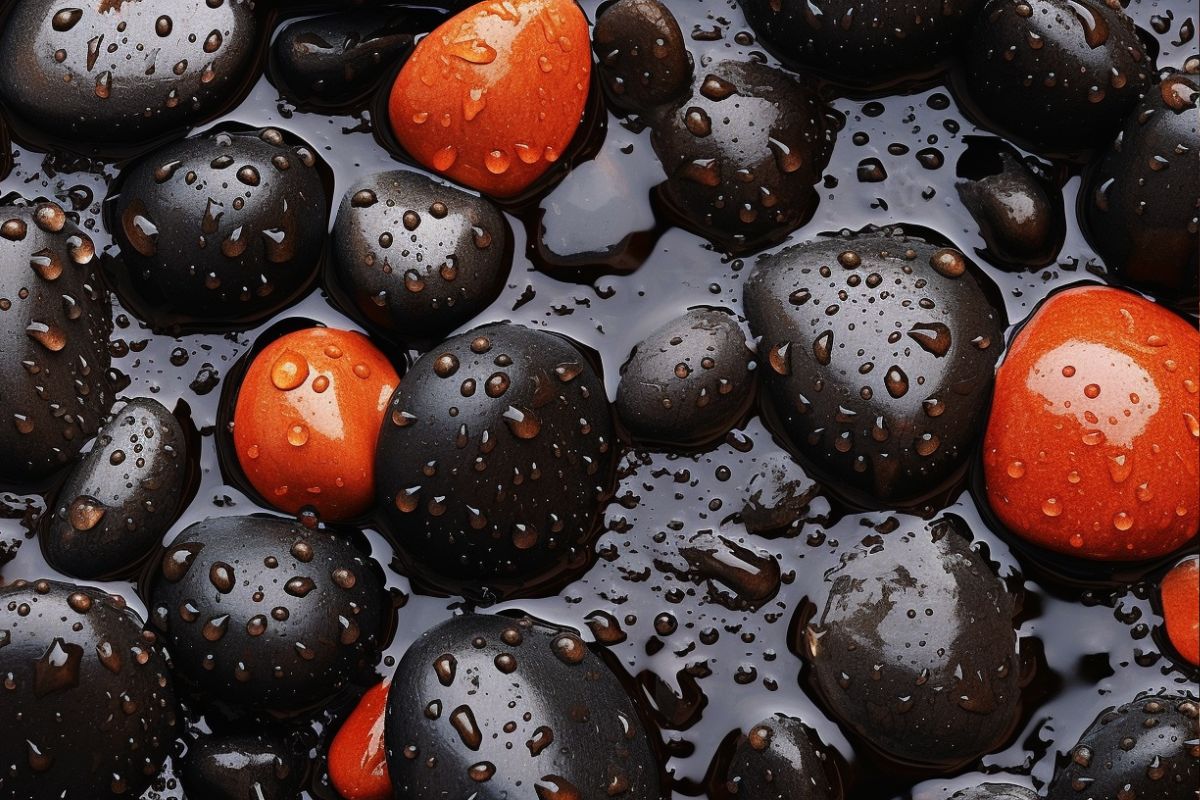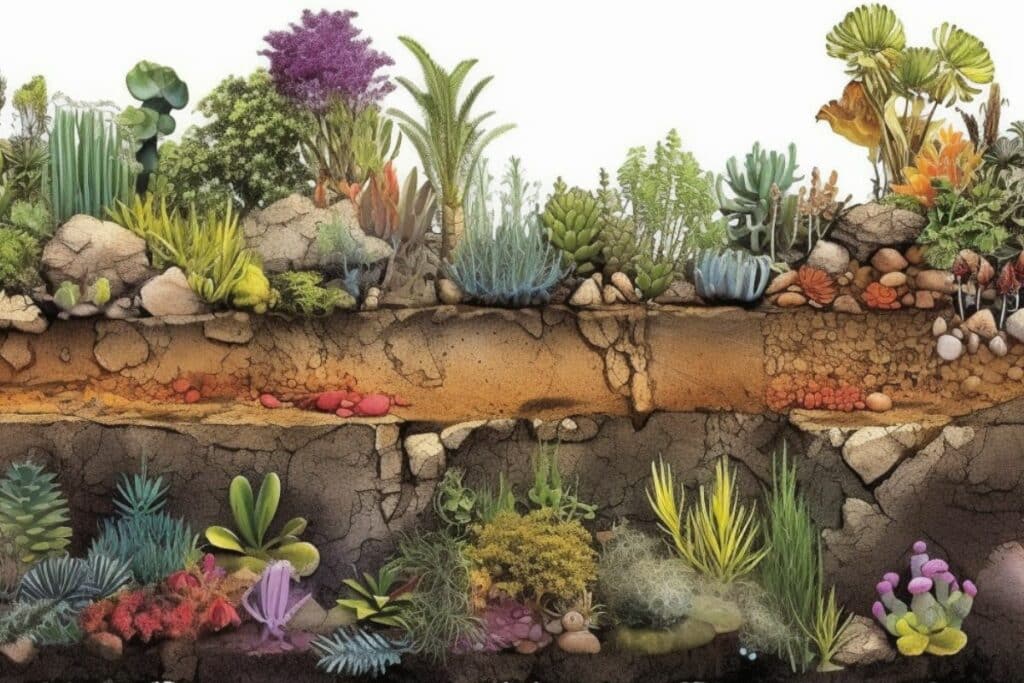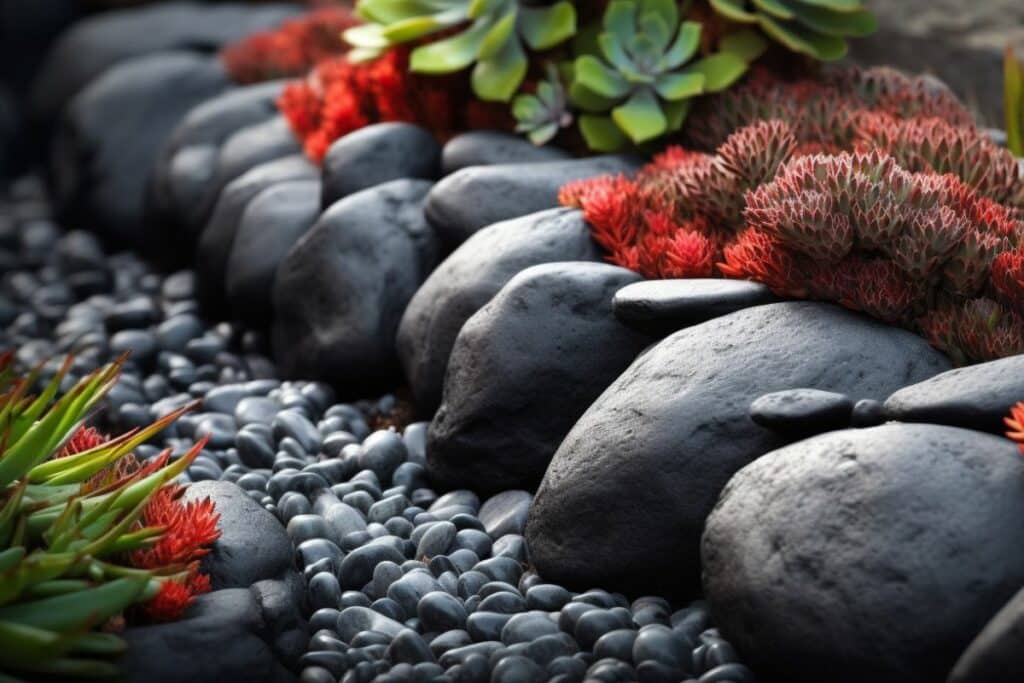
You might be contemplating the best material to use for drainage in your landscaping or gardening project.
One option that may have crossed your mind is lava rock, a popular choice among gardeners and landscapers alike due to its impressive qualities. But how does it compare to other materials when it comes to drainage?
By examining their unique properties and understanding how they interact with water and soil, you’ll gain valuable insights into whether this fascinating natural material fits your specific needs.
So let’s dive in together and unlock the secrets behind lava rocks – an unassuming yet powerful solution to many drainage challenges.
The Porous Nature of Lava Rock

Imagine feeling the porous surface of lava rock, with its countless tiny holes and channels that allow water to flow through easily, making it perfect for drainage. These porous benefits stem from the volcanic origins of lava rock formations, where molten material cools rapidly and traps gas bubbles within its structure.
As a result, this unique absorption capacity enables lava rocks to provide excellent drainage solutions in various garden applications.
In addition to their superior water management capabilities, lava rocks also have other properties that contribute to their popularity among gardeners and landscapers. For example, they’re lightweight due to their high porosity, making them easy to transport and arrange in your garden.
Moreover, their rough texture helps prevent soil erosion by slowing down water runoff during heavy rain or irrigation events.
Not only do these features make lava rocks an attractive option for drainage purposes, but they also provide aesthetic value by adding a natural element to landscapes.
When deciding whether or not to use lava rock for drainage purposes in your garden or landscaping project, consider both its functional advantages as well as its visual appeal.
The combination of efficient water management and the visually interesting appearance of these uniquely porous stones will undoubtedly enhance any outdoor space while providing effective drainage solutions.
So next time you plan a gardening project requiring improved drainage capabilities, don’t hesitate to explore the many benefits offered by incorporating lava rock into your design.
Comparing Lava Rock to Other Drainage Materials

Surprisingly, you’ll find that lava rock can hold up to 50% of its weight in water, making it more effective for drainage compared to other materials like sand or gravel.
This superior drainage efficiency is due to its porous nature and lightweight structure.
When comparing lava rock alternatives, it’s essential to evaluate their material properties as well as the specific requirements of your project.
Another alternative could be a French Drain. Read all about them here!
In terms of cost analysis, lava rock tends to be slightly more expensive than traditional drainage materials such as sand or gravel.
However, this increased cost may be justified by the improved performance and long-term benefits provided by lava rock.
Material comparisons show that while some cheaper options may initially seem appealing from a financial standpoint, they often result in reduced drainage efficiency and require more frequent replacement – ultimately leading to higher costs over time.
Additionally, it’s important to consider the environmental impact of your chosen drainage material; unlike non-renewable resources like sand or pebbles extracted from quarries, lava rock is a naturally occurring volcanic byproduct with minimal ecological disruption.
When weighing your options for an efficient drainage solution, don’t forget to take into account not only the initial costs but also long-term maintenance expenses and environmental considerations.
Lava rock’s superior water retention capabilities make it a worthwhile investment for projects requiring optimal water management without compromising on sustainability.
By carefully assessing all elements involved in material comparisons – including cost analysis and potential environmental impact – you can make an informed decision that best suits the needs of your project while contributing positively towards global ecology efforts.
If lava rocks are not the right ones for you because of the price, maybe you can find some good free rocks to help.
Advantages of Using Lava Rock for Drainage

You’ll be amazed at the benefits you can reap from using lava rock for your drainage needs. It provides an eco-friendly and efficient solution that stands out among other materials.
Lava rock’s porous structure allows for excellent water retention and absorption, leading to increased drainage efficiency. Its lightweight nature also makes it easy to transport and install in various landscaping projects.
Moreover, its natural formation process means that it has a smaller environmental footprint compared to other popular drainage materials like gravel or sand. One of the main lava benefits comes from its ability to improve soil aeration due to its porous nature.
This characteristic promotes healthy root growth by allowing air exchange between the soil particles, resulting in stronger and healthier plants.
Additionally, lava rock is highly resistant to erosion, which ensures long-lasting performance even when exposed to harsh weather conditions. Its durability makes it ideal for use not only in residential gardens but also in commercial landscapes and green roofs where proper water management is crucial.
Using lava rock as a drainage material offers cost-effective solutions without compromising on quality or functionality.
The natural properties of this versatile material provide exceptional value over time, reducing the need for frequent replacement or maintenance work.
With so many advantages at your disposal, incorporating lava rocks into your landscaping projects will undoubtedly result in better drainage efficiency while simultaneously promoting sustainable practices that benefit both you and the environment.
Potential Drawbacks and Considerations

While using lava rock for drainage offers numerous advantages, are there any potential drawbacks or considerations you should be aware of?
As with any landscaping material, it’s essential to weigh the pros and cons before making a decision. In this case, some factors to consider include lava durability, installation challenges, cost comparison, environmental impact, and maintenance requirements.
To help you assess these aspects more effectively, let’s explore them in detail through the table below.
| Factor | Consideration |
|---|---|
| Lava Durability | Although lava rock is quite durable and long-lasting compared to other materials like wood mulch or bark chips, it can break down over time due to physical weathering processes. This may cause its effectiveness as a drainage aid to decrease over time. |
| Installation Challenges | Over time dust particles accumulate between gaps in the porous structure of lava rocks, potentially clogging their pores thus reducing their ability for efficient water drainage; regular maintenance involving rinsing off accumulated debris is necessary to maintain their effectiveness as a drainage material. |
| Cost Comparison | Installing lava rocks for drainage purposes can be labor-intensive and requires proper planning. The rocks must be appropriately sized and placed at an optimal depth for effective drainage; incorrect installation can lead to inadequate water flow or even blockages in your system. Safety precautions must also be taken when handling sharp-edged rocks during installation. |
| Environmental Impact | While lava rock might seem a cost-effective solution initially due to its longevity compared to other materials such as wood chips or gravel, the higher upfront costs might outweigh the long-term benefits depending on your budget constraints and project size. |
| Maintenance Requirements | Over time dust particles accumulate between gaps in the porous structure of lava rocks, potentially clogging their pores, thus reducing their ability for efficient water drainage; regular maintenance involving rinsing off accumulated debris is necessary to maintain their effectiveness as a drainage material. |
Taking all these factors into account, it’s clear that while lava rock has its advantages for drainage purposes, there are also potential drawbacks and considerations worth factoring into your decision-making process.
By carefully evaluating the durability, installation challenges, cost comparison, environmental impact, and maintenance requirements associated with using lava rock for drainage, you can make an informed choice that meets your specific needs and preferences.
There are plenty of other cool rock ideas out there.
Conclusion and final thoughts ?
In conclusion, you’ll find that lava rock is indeed an effective drainage solution. Its porous nature allows water to flow through with ease, preventing standing water and promoting healthy plant growth.
Imagine a beautiful backyard garden flourishing thanks to the clever use of lava rock for drainage. By choosing this material over others, you’re making an informed decision based on its advantages and potential drawbacks, ensuring your plants thrive in optimal conditions.
While these rocks will make your backyard drainage even better, did you know there could be other valuable rocks in your backyard?


